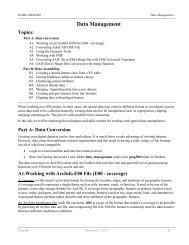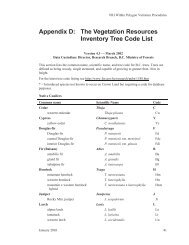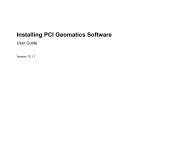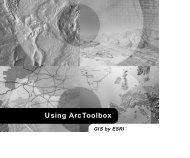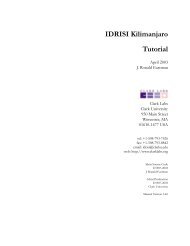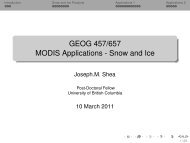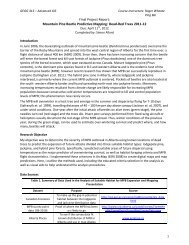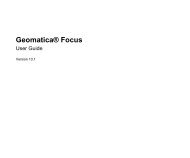Understanding Map Projections
Understanding Map Projections
Understanding Map Projections
You also want an ePaper? Increase the reach of your titles
YUMPU automatically turns print PDFs into web optimized ePapers that Google loves.
STATE PLANE COORDINATE SYSTEM<br />
DESCRIPTION<br />
Also known as SPCS, SPC, State Plane, and State.<br />
The State Plane Coordinate System is not a<br />
projection. It is a coordinate system that divides the<br />
50 states of the United States, Puerto Rico, and the<br />
U.S. Virgin Islands into more than 120 numbered<br />
sections, referred to as zones. Each zone has an<br />
assigned code number that defines the projection<br />
parameters for the region.<br />
PROJECTION METHOD<br />
Projection may be cylindrical or conic. See Lambert<br />
Conformal Conic, Transverse Mercator, and Hotine<br />
Oblique Mercator for methodology and properties.<br />
WHY USE STATE PLANE<br />
Governmental organizations and groups who work<br />
with them primarily use the State Plane Coordinate<br />
System. Most often, these are county or municipal<br />
databases. The advantage of using SPCS is that your<br />
data is in a common coordinate system with other<br />
databases covering the same area.<br />
WHAT IS STATE PLANE<br />
The State Plane Coordinate System was designed for<br />
large-scale mapping in the United States. It was<br />
developed in the 1930s by the U.S. Coast and<br />
Geodetic Survey to provide a common reference<br />
system to surveyors and mappers. The goal was to<br />
design a conformal mapping system for the country<br />
with a maximum scale distortion of one part in<br />
10,000, then considered the limit of surveying<br />
accuracy.<br />
Three conformal projections were chosen: the<br />
Lambert Conformal Conic for states that are longer<br />
east–west, such as Tennessee and Kentucky; the<br />
Transverse Mercator projection for states that are<br />
longer north–south, such as Illinois and Vermont;<br />
and the Oblique Mercator projection for the<br />
panhandle of Alaska, because it lays at an angle.<br />
To maintain an accuracy of one part in 10,000, it was<br />
necessary to divide many states into zones. Each<br />
zone has its own central meridian or standard<br />
parallels to maintain the desired level of accuracy.<br />
The boundaries of these zones follow county<br />
boundaries. Smaller states such as Connecticut<br />
require only one zone, while Alaska is composed of<br />
10 zones and uses all three projections.<br />
This coordinate system is referred to here as the<br />
State Plane Coordinate System of 1927 (SPCS 27). It<br />
is based on a network of geodetic control points<br />
referred to as the North American Datum of 1927<br />
(NAD 1927 or NAD27).<br />
STATE PLANE AND THE NORTH AMERICAN<br />
DATUM<br />
Technological advancements of the last 50 years<br />
have led to improvements in the measurement of<br />
distances, angles, and the earth’s size and shape.<br />
This, combined with moving the origin of the datum<br />
from Meades Ranch in Kansas to the earth’s center of<br />
mass for compatibility with satellite systems, made it<br />
necessary to redefine SPCS 27. The redefined and<br />
updated system is called the State Plane Coordinate<br />
System of 1983 (SPCS 83). The coordinates for points<br />
are different for SPCS 27 and SPCS 83. There are<br />
several reasons for this. For SPCS 83, all State Plane<br />
coordinates published by NGS are in metric units,<br />
the shape of the spheroid of the earth is slightly<br />
different, some states have changed the definition of<br />
their zones, and values of longitude and latitude are<br />
slightly changed.<br />
Officially, SPCS zones are identified by their NGS<br />
code. When ESRI ® implemented the NGS codes, they<br />
were part of a proposed Federal Information<br />
Processing Standard (FIPS). For that reason, ESRI<br />
identifies the NGS zones as FIPS zones. That<br />
proposed standard was withdrawn, but ESRI<br />
maintains the FIPS name for continuity.<br />
Sometimes people use an older Bureau of Land<br />
Management (BLM) system. The BLM system is<br />
outdated and doesn’t include codes for some of the<br />
new zones. The values also overlap. You should<br />
always use the NGS/FIPS codes.<br />
The following zone changes were made from<br />
SPCS 27 to SPCS 83. The zone numbers listed below<br />
are FIPS zone numbers. In addition, false easting and<br />
northing, or origin, of most zones has changed.<br />
California—California zone 7, SPCS 27 FIPS<br />
zone 0407, was eliminated and included in California<br />
zone 5, SPCS 83 FIPS zone 0405.<br />
Supported map projections• 85




